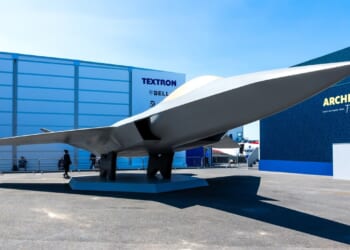The S-97 fills a critical gap in modern warfare by providing rapid insertion of troops, conducting intelligence gathering, and performing direct fire support.
In the ever-evolving landscape of military aviation, the Lockheed Martin S-97 Raider stands out as a truly groundbreaking prototype that pushes the boundaries of US military helicopter technology.
Developed by Sikorsky Aircraft, a Lockheed Martin subsidiary, the S-97 Raider is a high-speed scout and attack compound helicopter designed to redefine aerial reconnaissance and combat operations. With its innovative coaxial rotor system and pusher propeller, this next generation aircraft promises unprecedented speed, agility, and versatility for modern battlefields.
The S-97 Raider’s Origins
Back in 2010, the United States Army’s Armed Aerial Scout Program aimed to replace iconic, though aging, helicopters like the OH-58 Kiowa with a more advanced platform capable of high-speed operations. Drawing from the proven X2 Technology demonstrator, which achieved speeds of over 250 knots in 2010, Sikorsky accelerated development to create a prototype that could carry troops and weapons while maintaining superior maneuverability.
The first prototype of the S-97 Raider was rolled out in 2014, and it achieved its maiden flight on May 22, 2015, at Sikorsky’s facility in West Palm Beach, Florida. Early testing focused on validating the Advancing Blade Concept (ABC), which uses rigid coaxial rotors to eliminate issues like retreating blade stall at high speeds. The program faced challenges, however, including a hard landing in August 2017 that temporarily halted flights,
Two prototypes of the S-97 were constructed, with the second of the two initially serving as a ground test vehicle. The S-97 Raider was positioned as a contender for the Army’s Future Attack Reconnaissance Aircraft (FARA) program, leading to the development of the larger Raider X variant. Unfortunately, the FARA program was canceled in February 2024 due to shifting priorities toward unmanned systems and budget constraints. This cancellation left the Raider X prototype unflown—but Sikorsky has persisted with S-97, keeping it alive to demonstrate technologies for potential export and international collaborations.
The S-97 Raider’s Specifications
- Manufacturer: Sikorsky (Lockheed Martin)
- Year Introduced: Not yet introduced (first flight 2015)
- Number Built: 3
- Type: Light tactical helicopter
- Rotor diameter: 34 ft (10.36 m)
- Engine: one General Electric YT706, 2,600 shp (1,900 kW)
- Cruise speed: 220+ knots (253 mph or 407 kmh)
- Range: 372 mi (600 km)
- Crew: Up to 6
At the heart of the S-97 Raider’s design is its coaxial rotor system, featuring two counter-rotating rigid rotors that provide lift and eliminate the need for a traditional tail rotor. The composite airframe enhances durability and reduces weight, while advanced avionics support precise low-speed handling, high turn rates, and level body acceleration. Potential armaments include Hellfire missiles, 2.75-inch rockets, a .50-caliber main gun, and a 7.62 mm machine gun.
Compared to traditional helicopters, the S-97’s design allows for a 200-knot cruise speed and dives on targets with exceptional agility. Indeed, Lockheed claims that the targeted top speed of the S-97 is between 220-230 knots (250-265 mph)—nearly double that of many legacy helicopters, such as the UH-60 Black Hawk. Flight tests have already reached 202 knots, demonstrating its potential to outpace adversaries in contested environments. Its compound configuration enables hovering at low speeds with pinpoint accuracy, rapid acceleration, and the ability to maneuver in urban or rugged terrains.
The S-97 Fills a Critical Gap in America’s Defenses
Innovations like the X2 Technology both boost speed as well as fuel efficiency—all while reducing noise and enhancing stealth capabilities. Earlier this year, Sikorsky showcased the S-97 at the Paris Air Show, highlighting its international debut and ongoing advancements in rotorcraft technology.
The S-97 fills a critical gap in modern warfare by providing rapid insertion of troops, conducting intelligence gathering, and performing direct fire support. This helicopter’s ability to carry external weapons and operate in high-threat areas makes it ideal for special operations, counter-terrorism, and reconnaissance missions.
In a post-FARA era, the platform’s adaptability positions it as a valuable asset for allied forces facing evolving threats from peer competitors.
Despite its promise, the S-97 has faced hurdles, including the FARA cancellation and competition from drones. Lockheed Martin is, however, pivoting to export markets, eyeing NATO’s Next Generation Rotorcraft Capability (NGRC) program and partnerships in Europe and South Korea. As of August 2025, ongoing flights of the prototypes continue to validate new technologies, with Sikorsky seeking collaborators to build in Europe.
About the Author: Brandon J. Weichert
Brandon J. Weichert is a senior national security editor at The National Interest. He is also a contributor at Popular Mechanics, and has consulted regularly with various government institutions and private organizations on geopolitical issues. Weichert’s writings have appeared in multiple publications, including The Washington Times, National Review, The American Spectator, MSN, The Asia Times, and countless others. His books include Winning Space: How America Remains a Superpower, Biohacked: China’s Race to Control Life, and The Shadow War: Iran’s Quest for Supremacy. His newest book, A Disaster of Our Own Making: How the West Lost Ukraine is available for purchase wherever books are sold. He can be followed via Twitter @WeTheBrandon.
Image: Shutterstock / VanderWolf Images.

















